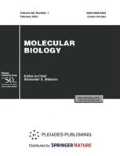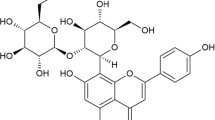Abstract
Due to wide spreading of inflammatory disease and imperfection of available anti-inflammatory drugs, mainly associated with their serious side effects, searching for new anti-inflammatory agents is a pressing problem. Natural triterpenoids and their synthetic analogs are a promising source of new drugs. In this study, we have investigated the anti-inflammatory and antitumor effects in vivo of the glycyrrhetinic acid derivative soloxolone methyl (SM), or methyl 2-cyano-3,12-dioxo-18βH-olean-9(11),1(2)-dien-30-oate. SM was shown to efficiently suppress the development of edema in a mouse model of carrageenan- or histamine- induced acute inflammation. SM also inhibited the tumor growth and reduced the tumor cell count in the ascitic fluid in mice bearing Krebs-2 carcinoma, the development of which is accompanied by an inflammatory process in the surrounding tissues.
Similar content being viewed by others
Abbreviations
- DMSO:
-
dimethyl sulfoxide
- LPS:
-
lipopolysaccharide
- NSAID:
-
nonsteroidal anti-inflammatory drug
- SM:
-
soloxolone methyl
- PBS:
-
phosphate-buffered saline
- COX-2:
-
cyclooxygenase 2
References
Loeb D.S., Ahlquist D.A., Talley N.J. 1992. Management of gastroduodenopathy associated with use of nonsteroidal anti-inflammatory drugs. Mayo Clin. Proc. 67, 354–364.
Champion G.D., Feng P.H., Azuma T., et al. 1997. NSAID-induce gastrointestinal damage: Epidemiology, risk and prevention, with an evaluation of the role of misoprostol. An Asia-Pacific perspective and consensus. Drugs. 53, 6–19.
Nathan C., Ding A. 2010. Nonresolving inflammation. Cell. 140, 871–882.
Coussens L.M., Werb Z. 2002. Inflammation and cancer. Nature. 420, 860–867.
Aggarwal B.B., Shishodia S., Sandur S.K., et al. 2006. Inflammation and cancer: How hot is the link? Biochem. Pharmacol. 72, 1605–1621.
Li J.Y., Cao H.Y., Liu P., et al. 2014. Glycyrrhizic acid in the treatment of liver diseases: Literature review. Biomed. Res. Int. 2014, 872139.
Pompei R., Laconi S., Ingianni A. 2009. Antiviral properties of glycyrrhizic acid and its semisynthetic derivatives. Mini-Rev. Med. Chem. 9, 996–1001.
Roohbakhsh A., Iranshahy M., Iranshahi M. 2016. Glycyrrhetinic acid and its derivatives: Anti-cancer and cancer chemopreventive properties, mechanisms of action and structure-cytotoxic activity relationship. Curr. Med. Chem. 23, 498–517.
Langer D., Czarczynska-Goslinska B., Goslinski T. 2016. Glycyrrhetinic acid and its derivatives in infectious diseases. Curr. Issues Pharm. Med. Sci. 29, 118–123.
Ming L.J., Yin A.C. 2013. Therapeutic effects of glycyrrhizic acid. Nat. Prod. Commun. 8, 415–418.
Grabowski P.S., Wright P.K., Van’t Hof R.J., et al. 1997. Immunolocalization of inducible nitric oxide synthase in synovium and cartilage in rheumatoid arthritis and osteoarthritis. Br. J. Rheumatol. 36, 651–655.
Lallemand B., Gelbcke M., Dubois J., Prévost M., Jabin I., Kiss R. 2011. Structure–activity relationship analyses of glycyrrhetinic acid derivatives as anticancer agents. Mini-Rev. Med. Chem. 11, 881–887.
Markov A.V., Zenkova M.A., Logashenko E.B. 2017. Modulation of tumour-related signaling pathways by natural pentacyclic triterpenoids and their semisynthetic derivatives. Curr. Med. Chem. 24, 1277–1320.
Liby K.T., Sporn M.B. 2012. Synthetic oleanane triterpenoids: Multifunctional drugs with a broad range of applications for prevention and treatment of chronic disease. Pharmacol. Rev. 64, 972–1003.
Chintharlapalli S., Papineni S., Jutooru I., et al. 2007. Structure-dependent activity of glycyrrhetinic acid derivatives as peroxisome proliferator-activated receptor {gamma} agonists in colon cancer cells. Mol. Cancer Ther. 6, 1588–1598.
Chadalapaka G., Jutooru I., McAlee A., et al. 2008. Structure-dependent inhibition of bladder and pancreatic cancer cell growth by 2-substituted glycyrrhetinic and ursolic acid derivatives. Bioorg. Med. Chem. Lett. 18, 2633–2639.
Logashenko E.B., Salomatina O.V., Markov A.V., et al. 2011. Synthesis and pro-apoptotic activity of novel glycyrrhetinic acid derivatives. ChemBioChem. 12, 784–794.
Popadyuk I.I., Markov A.V., Salomatina O.V., et al. 2015. Synthesis and biological activity of novel deoxycholic acid derivatives. Bioorg. Med. Chem. 23, 5022–5034.
Guzik T.J., Korbut R., Adamek-Guzik T. 2003. Nitric oxide and superoxide in inflammation and immune regulation. J. Physiol. Pharmacol. 54, 469–487.
Salomatina O.V., Markov A.V., Logashenko E.B., et al. 2014. Synthesis of novel 2-cyano substituted glycyrrhetinic acid derivatives as inhibitors of cancer cells growth and NO production in LPS-activated J-774 cells. Bioorg. Med. Chem. 22, 585–593.
Morris C.J. 2003. Carrageenan-induced paw edema in the rat and mouse. Methods Mol. Biol. 225, 115–121.
Gepdiremen A., Mshvildadze V., Suleyman H., et al. 2004. Acute and chronic antiinflammatory effects of Hedera colchica in rats. J. Ethnopharmacol. 94, 191–195.
Perianayagam J.B., Sharma S.K., Pillai K.K. 2006. Anti-inflammatory activity of Trichodesma indicum root extract in experimental animals. J. Ethnopharmacol. 104, 410–414.
Tubaro A., Dri P., Delbello G., et al. 1986. The croton oil ear test revisited. Agents Actions. 17, 347–349.
Salvemini D., Wang Z.Q., Wyatt P.S., et al. 1996. Nitric oxide: A key mediator in the early and late phase of carrageenan-induced rat paw inflammation. Br. J. Pharmacol. 118, 829–838.
Radomski M.W., Palmer R.M., Moncada S. 1990. An L-arginine/nitric oxide pathway present in human platelets regulates aggregation. Proc. Natl. Acad. Sci. U. S. A. 87, 5193–5197.
Lee Y.M., Hirota S., Jippo-Kanemoto T., et al. 1996. Inhibition of histamine synthesis by glycyrrhetinic acid in mast cells cocultured with Swiss 3T3 fibroblasts. Int. Arch. Allergy Immunol. 110, 272–277.
Imanishi N., Kawai H., Hayashi Y., et al. 1989. Effects of glycyrrhizin and glycyrrhetinic acid on dexamethasone-induced changes in histamine synthesis of mouse mastocytoma P-815 cells and in histamine release from rat peritoneal mast cells. Biochem. Pharmacol. 38, 2521–2526.
Liu J. 1995. Pharmacology of oleanolic acid and ursolic acid. J. Ethnopharmacol. 49, 57–68.
Lee J.Y., Moon H., Kim C.J. 2010. Effects of hydroxy pentacyclic triterpene acids from Forsythia viridissima on asthmatic responses to ovalbumin challenge in conscious guinea pigs. Biol. Pharm. Bull. 33, 230–237.
Hu L.N, Fang X.Y., Liu H.L., et al. 2013. Protective effects of 18ß-glycyrrhetinic acid on LPS-induced injury in intestinal epithelial cells. Chin. J. Nat. Med. 11, 24–29.
Luo L., Jin Y., Kim I.D., Lee J.K. 2013. Glycyrrhizin attenuates kainic acid-induced neuronal cell death in the mouse hippocampus. Exp. Neurobiol. 22, 107–115.
Deeb D., Gao X., Jiang H., et al. 2009. Oleanane triterpenoid CDDO-Me inhibits growth and induces apoptosis in prostate cancer cells by independently targeting pro-survival Akt and mTOR. Prostate. 69, 851–860.
Fukumitsu S., Villareal M.O., Fujitsuka T., et al. 2016. Anti-inflammatory and anti-arthritic effects of pentacyclic triterpenoids maslinic acid through NF-kB inactivation. Mol. Nutr. Food Res. 60, 399–409.
Kulkarni S.K., Mehta A.K., Kunchandy J. 1986. Antiinflammatory actions of clonidine, guanfacine and B HT 920 against various inflammagen-induced acute paw oedema in rats. Arch. Int. Pharmacodyn. Ther. 279, 324–334.
Nagy J.A., Benjamin L., Zeng H., et al. 2008. Vascular permeability, vascular hyperpermeability and angiogenesis. Angiogenesis. 11, 109–119.
Rozenberg I., Sluka S.H., Rohrer L., et al. 2010. Histamine H1 receptor promotes atherosclerotic lesion formation by increase vascular permeability for low-density lipoproteins. Arterioscler. Thromb. Vasc. Biol. 30, 923–930.
Yong Y.K., Zakaria Z.A., Kadir A.A., et al. 2013. Chemical constituents and antihistamine activity of Bixa orellana leaf extract. BMC Complementary Altern. Med. 13,32.
Grivennikov S.I., Greten F.R., Karin M. 2010. Immunity, inflammation, and cancer. Cell. 140, 883–899.
Parsons D.F., Marko M., Braun S.J., et al. 1982. Ascites tumor invasion of mouse peritoneum studied by high-voltage electron microscope stereoscopy. Cancer Res. 42, 4574–4583.
Parsons D.F., Marko M., Wansor K.J. 1983. Inflammation with restricted lysosomal proteolysis during early ascites carcinoma invasion of mouse parietal peritoneum. A medium and high-voltage electron microscopic and cytochemical study. Tissue Cell. 15, 499–507.
Auletta J.J., Alabran J.L., Kim B.G., et al. 2010. The synthetic triterpenoid, CDDO-Me, modulates the proinflammatory response to in vivo lipopolysaccharide challenge. J. Interferon Cytokine Res. 30, 497–508.
Chen T., Mou Y., Tan J., et al. 2015. The protective effect of CDDO-Me on lipopolysaccharide-induced acute lung injury in mice. Int. Immunopharmacol. 25, 55–64.
Wang Y.Y., Yang Y.X., Zhao R., et al. 2015. Bardoxolone methyl induces apoptosis and autophagy and inhibits epithelial-to-mesenchymal transition and stemness in esophageal squamous cancer cells. Drug Des., Dev. Ther. 9, 993–1026.
To C., Kulkarni S., Pawson T., et al. 2008. The synthetic triterpenoid 2-cyano-3,12-dioxooleana-1,9-dien-28-oic acid-imidazolide alters transforming growth factor beta-dependent signaling and cell migration by affecting the cytoskeleton and the polarity complex. J. Biol. Chem. 283, 11700–11713.
Sogno I., Vannini N., Lorusso G., et al. 2009. Antiangiogenic activity of a novel class of chemopreventive compounds: Oleanic acid terpenoids. Recent Results Cancer Res. 181, 209–212.
Ball M.S., Shipman E.P., Kim H., et al. 2016. CDDOMe redirects activation of breast tumor associated macrophages. PLoS One. 11, e0149600.
Rayburn E.R., Ezell S.J., Zhang R. 2009. Anti-inflammatory agents for cancer therapy. Mol. Cell. Pharmacol. 1, 29–43.
Author information
Authors and Affiliations
Corresponding author
Additional information
Original Russian Text © A.V. Markov, A.V. Sen’kova, M.A. Zenkova, E.B. Logashenko, 2018, published in Molekulyarnaya Biologiya, 2018, Vol. 52, No. 2, pp. 306–313.
Rights and permissions
About this article
Cite this article
Markov, A.V., Sen’kova, A.V., Zenkova, M.A. et al. Novel Glycyrrhetinic Acid Derivative Soloxolone Methyl Inhibits the Inflammatory Response and Tumor Growth in vivo. Mol Biol 52, 262–268 (2018). https://doi.org/10.1134/S0026893318020073
Received:
Accepted:
Published:
Issue Date:
DOI: https://doi.org/10.1134/S0026893318020073




